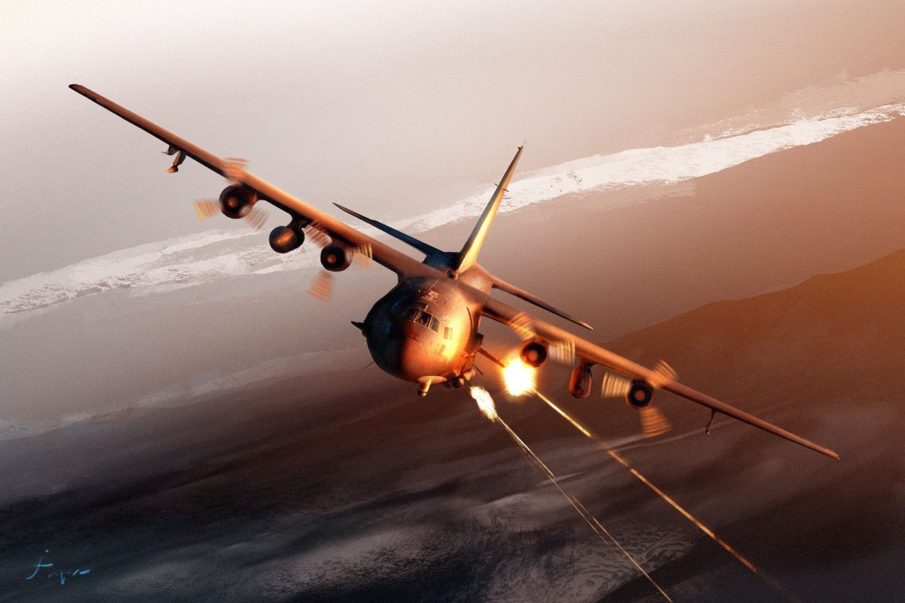“The sound of an AC-130 Gunship has had our enemies looking to the skies in fear for the last 50 years,” the narrator tells us at the start of a U.S. Special Operations Command (USSOCOM) video celebrating the 50th anniversary of the ground attack aircraft this month. The airframe is basically a fixed-wing transport aircraft with a whole crap-ton of anti-ground weapons affixed to it, for use in supporting ground troops and laying the hurt down on enemy ground forces.
According to the video, guns were first mounted to the side of an AC-47 transport plane during the Vietnam War. The AC-47 was called “Spooky” and “Puff the Magic Dragon,” which referred to the way the guns erupted from the aircraft like puffs of dragon fire. The AC-47 then evolved into the AC-119 around 1968, and was officially called the “Shadow,” but also unofficially known as “Creep.”
In 1967, the original AC-130 Gunship was introduced, and was used primarily for night attacks. This preference continues on today, and is due primarily to the aircraft’s low operating altitude (7,000 feet) and large profile.
The original AC-130H Spectre was fielded in 1972, and was equipped with two 20mm Gatling guns, along with a 40mm cannon, and a 105mm Howitzer. That’s a whole lot of pain to rain down. The Spectre was recently retired from service. The upgraded AC-130U “Spooky” has a single 25mm cannon in place of the Spectre’s two 20mm cannons, as well as an improved fire control system and increased ammunition capacity.
The W model of the AC-130, or “Stinger II,” was equipped with a precision strike package: its armaments include one 30mm Bushmaster cannon, AGM-176 Griffin missiles, and GBU-39 Small Diameter Bombs (SDBs). These precision guided munitions allow the Stinger II to put munitions on target in a far more effective manner.
The AC-130 Gunships are based primarily at Hurlburt Field, Florida — home of the Air Force Special Operations Command (AFSOC) — and Cannon AFB in New Mexico. They are operated solely by AFSOC, and are a justifiably prized possession of the service.
Uniquely, the gunships have their weaponry mounted to fire from the left side of the aircraft’s fuselage, and during an attack, they perform what is called a “pylon turn,” essentially flying in a large circle around the target. This allows them to fire at a target for far longer than a conventional “strafing” attack, in which an aircraft approaches a target, fires, and then flies off target to come back around for another run at it.
It is no understatement to say that ground-based Special Operations Forces (SOF) love these aircraft, and view them as invaluable assets for affording protection and fire support from the sky. The gunships can escort convoys, perform armed reconnaissance, and participate in urban operations, in addition to their role laying waste to enemy ground forces.
The 5th generation of the AC-130 Gunship, the J model “Ghostrider,” was introduced recently into the AFSOC inventory. The newest addition to the family is set to be the most heavily-armed gunship in history, according to the Air Force Times, as it will bristle with 30mm and 105mm cannons, AGM-176A Griffin missiles, and the ability to carry Hellfire missiles and GBU-39 SDBs.
The newest model may also be equipped with a high-energy laser, at some point, though that remains to be seen. A gunship with frikin’ laser beams on it! Ground attack is about to get a whole lot more real.
It remains to be seen if these lumbering harbingers of death-from-above will one day be phased out and replaced by unmanned drones, more stealthy manned aircraft, or some other technological innovation that overcomes their vulnerability to attack from the ground.
Already have an account? Sign In
Two ways to continue to read this article.
Subscribe
$1.99
every 4 weeks
- Unlimited access to all articles
- Support independent journalism
- Ad-free reading experience
Subscribe Now
Recurring Monthly. Cancel Anytime.
Until then, they will continue to offer our ground forces a security blanket and attack capability unique to the U.S. military and one we should all be happy we possess.
Below you can see USSOCOM’s short video on the anniversary of the AC-130:
(featured image courtesy of wallpapercave.com).











COMMENTS
You must become a subscriber or login to view or post comments on this article.